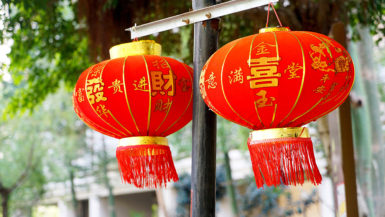Amid the boom of firecrackers a year has come to an end,
And the spring wind has wafted warm breath to the wine.
While the rising sun shines over each and every household,
People would put up new peachwood charm for the old.
Wang Anshi
On A Cold New Year’s Eve
I tell those who roam, to make light of cold.
Spring wind will soon come, eastwards as foretold.
Yu Qian
While both of these Chinese poems were inspired by the same subject, they come from different dynasties and were written more than 400 years apart. Despite those distances between them, it is startlingly revealing and of some interest how similar they are in the political background of the poets, their life stories, the nature of the rulers and political systems that they served in ancient China, as well as their influence and reputations in modern China.

These poems help to define the Chinese New Year. They are selected from classical Chinese poetry and written by eminent men who are important to the tradition and heritage of that country. Wang Anshi served his nation as a prominent government administrator and wrote in the eleventh century, while Yu Qian also held high national office and wrote in the fifteenth century.
The Chinese recently celebrated the Lunar New Year – designated the beginning of the Year of the Rooster. It is marked with a grand calendar festival: the largest and most important national holiday in China. It is also known as the Spring Festival and is the country’s greatest traditional festival with its roots in myth and custom.
Chinese New Year is celebrated in China over a period of seven days – this year from January 27 to February 2, which were national public holidays. It is marked by extensive festive activities, the dragon dance, the lion dance, revelry and performances in keeping with youthful spring festivals in the urban centres while some of the traditional beliefs and observances that propagate the mythology and traditions may be more commemorated in rural regions.
Some of these are reflected in the verses which are usually very brief and express elements of the spring festival, new year beliefs and traditions, and sentiments arising from the season that is known by all. These include seemingly routine and insignificant references to “firecrackers”, “spring”, “wine”, “rising sun”, “household” and “new peachwood charm” in the Wang poem.
The Chinese celebrate in several ways in accordance with a number of beliefs. The New Year’s Eve dinner with the family, known as Reunion Dinner is regarded as the most important meal of the year, in addition to that there is other feasting and several practices which have to do with families. Gifts are given, including monetary presents in red envelopes, very significant because the colour is associated with new years and good luck. Accordingly, there is an abundance of red decorations and red lanterns. Other gifts include new clothes, including red garments.
The occasion is also linked to good luck as well as discarding the old for the new, with the belief that things of the old year must be changed for the new to send away the bad luck and bring in the good. There are changes of clothing, thorough cleaning of houses to prevent old bad luck from hanging around. Firecrackers are also blasted off for this purpose, to chase away bad and herald new fortunes – the louder the firecracker, the better the luck.
However, these traditions also originated in mythology, and are still linked to it – particularly the red colour and the firecrackers. Both the new year rituals and the spring festival have their origins in myth and ancient tradition. The festival has agricultural roots when it was the start of a new year of farm work with wishes for a good harvest. A good start was regarded as a sign of good luck for the year to come.
The most interesting origins and explanations are found in the myth. The people were plagued by visits from a creature known as the Nian, which would come once a year and eat children or other persons and animals. They started preparing for the visits by leaving food outside their doors at the time when Nian would come so he would eat that and leave the children alone. They later discovered that the creature was afraid of loud noises and of the colour red. They then began to put up red lanterns and other red things at the doors and wear clothes of that colour to keep him off. Firecrackers then came into play when the people began to light them at the appropriate time to chase away the Nian, who stopped visiting altogether.
The real history is equally interesting in the way the life and work of the poets mirror each other even though they lived centuries apart. Wang Anshi (1021 – 1086) was a prominent statesman, chancellor, economist and poet of the Song Dynasty who was most famous for the New Policies. These were very controversial socioeconomic reforms that he introduced during his period of government service. He was very brilliant and started his career by performing excellently at the civil service examinations. But he later sought to change the nature of those exams as well as to reform the management of the nation in ways more beneficial to the people, more efficient and with less corruption.
According to the BBC, during his ascendancy “everything Wang Anshi touched turned to gold.” With remarkable similarity, Yu Qian (1398 – 1457) of the Ming Dynasty rose to high positions in the government and impressed the emperor because of his brilliant work. He also endeared himself to the people for whose improvement he worked. He was known to resist corruption and to gain enemies because of this.
Both men had long periods when their fortunes soared, along with their influence, reputation and good works. But their fortunes changed and there were periods when they fell out of favour because of the various plots of their powerful enemies who were bothered by their principled positions against corruption.
Throughout history they were at times discredited but were restored to lofty positions of respect, official endorsement and public acceptance in the twentieth century. Their poetry and prose writings are classical works and are very famous in China.
The Wang poem makes direct references to the New Year traditions which have survived including the firecrackers and the importance of the customs that have to do with households. The revelry of the spring festival is also reflected in the mention of wine, while the predominance of wishes for good luck is also there in the “charm” mentioned in the poem.
The Yu poem dwells on the cold of the climate, the spring and the pervading sense of good fortunes which is such a strong spirit in the traditional New Year.
Here is another classical poem on a different subject for which Wang is famous.
Green in the spring winds
the south bank of the Yangtse
When will the bright moon
light my journey home
Yu was known for his principled resolve which he would not compromise.
Pounded, chiselled myriad times, deep in the hills I was mined;
Be burned and blazed in raging fire is but nothing, to my mind.
My bones be crushed, body severed, shall brave it all, and more,
To leave behind an impeccable white to remain with humankind.








